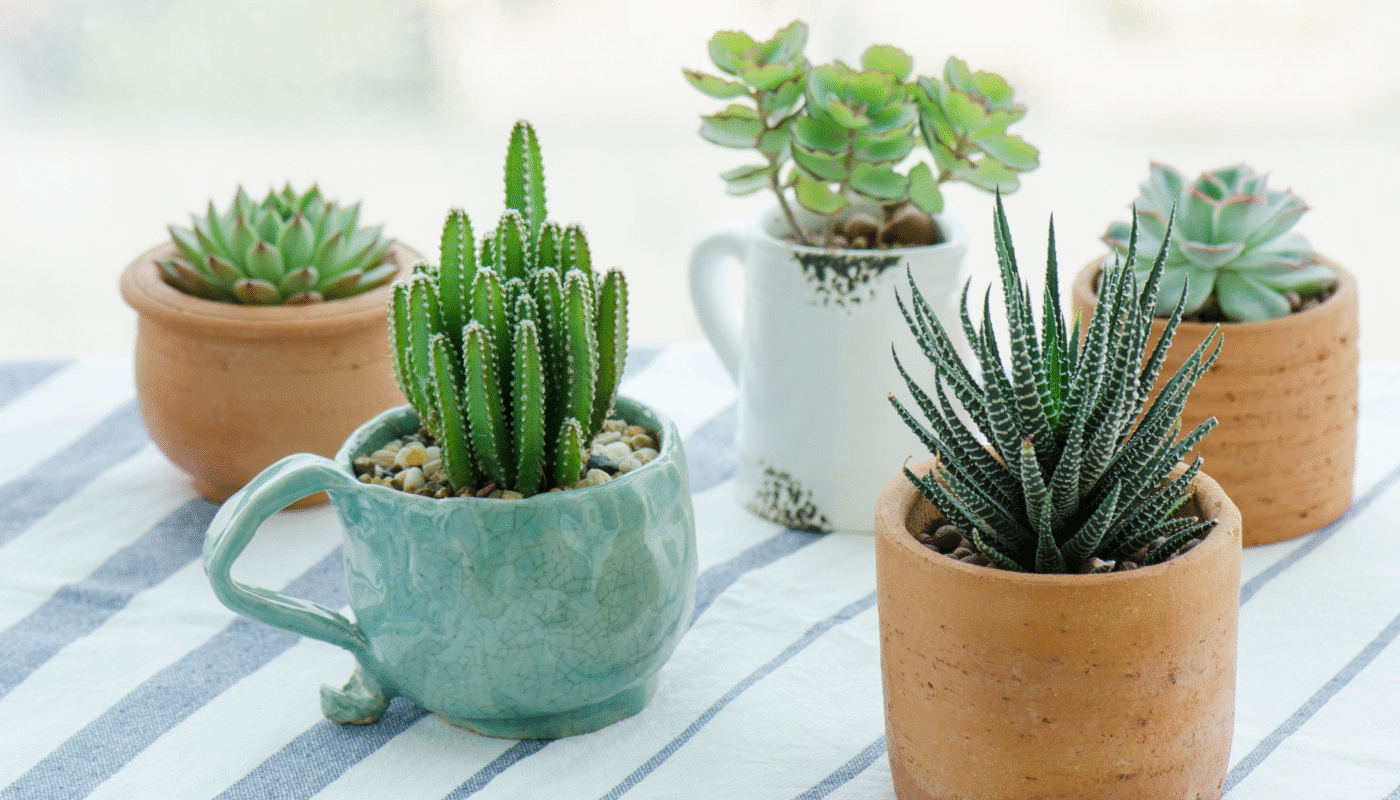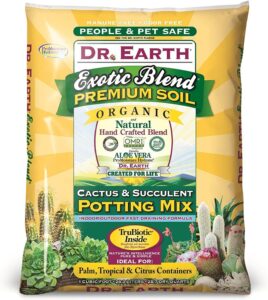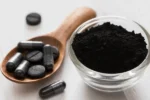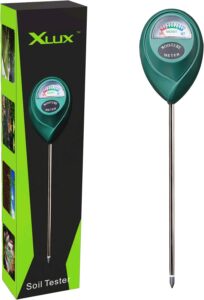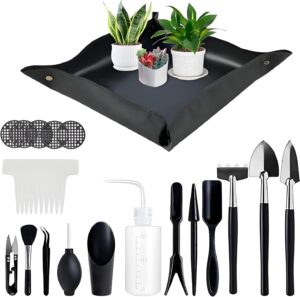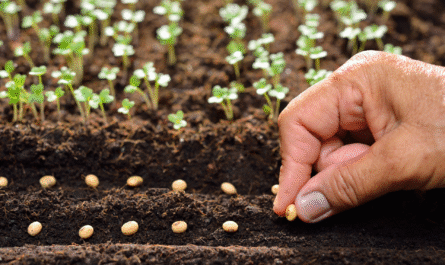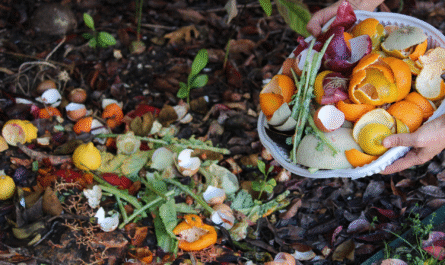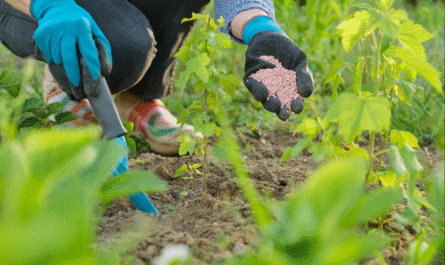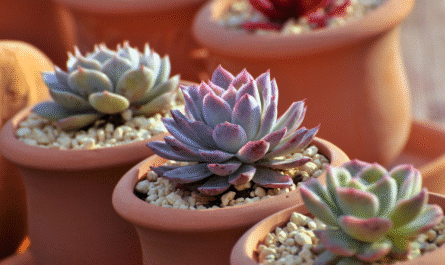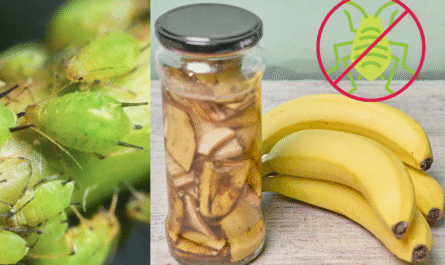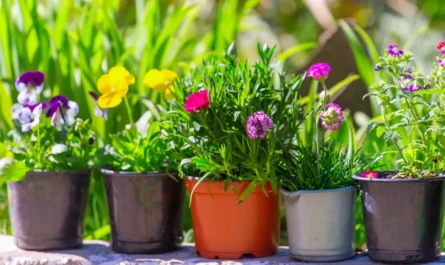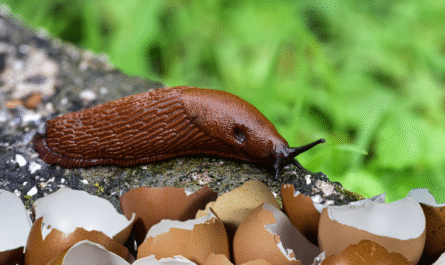Learning how to maintain succulents indoors starts with understanding their unique needs. Succulents are often praised for being low-maintenance, but they still require the right conditions to truly thrive.
Whether you’re a beginner or just looking to keep your collection healthy, this guide will walk you through the essentials of how to care for succulents, from choosing the right container to troubleshooting common issues.
1. Select the Right Pot with Drainage
Good succulent plants care starts with the container. The number one rule? It must have drainage holes. Succulents hate standing in water. When excess moisture can’t escape, root rot quickly follows. Opt for a breathable material like terracotta or unglazed ceramic.
Recommended Product:
D’vine Dev Terracotta Planter Pots with Drainage Hole and Saucer
These pots are the perfect size for small succulents and promote healthy root drying.
Size also matters. Don’t go too big—stick with something just slightly wider than the root ball. A pot that’s too large will hold moisture longer than necessary.
Many beginners fall into the trap of using decorative pots without drainage. If you love the look, use a plastic insert pot inside your decorative one. This trick keeps your succulent happy and your aesthetics intact.
Also Read: 50 Succulent Plant Fun Facts You Don’t Know
2. Use a Fast-Draining Soil Mix
Choosing the right soil is critical for succulents care. Standard potting soil holds too much moisture. You need a mix that drains quickly and retains very little water.
Recommended Product:
Dr. Earth 810 Exotic Cactus & Succulent Soil
This ready-to-use mix is designed specifically for succulents and cacti.
You can also mix your own: 2 parts potting soil, 1 part coarse sand, and 1 part perlite or pumice. Always test the soil’s drainage before planting by watering and seeing how quickly it flows through.
A good soil base promotes healthy roots and reduces the risk of rot. If you’re serious about how to take care of succulents, never underestimate the soil.
3. Water Correctly and Infrequently
How to grow succulents indoors involves resisting the urge to water too often. These plants store water in their leaves, so overwatering is a quick path to problems.
Only water when the soil is completely dry. Stick your finger about an inch down to check. When it’s dry, water thoroughly until it drains out the bottom. Then leave it alone.
Recommended Product:
A simple tool that tells you when your soil is dry, taking the guesswork out of watering.
On average, you might water every 10-14 days, but this depends on humidity, temperature, and light. Use your eyes and fingers, not a calendar.
Mastering watering is essential in how to care for succulents indoors. Less is more, and it’s always better to underwater than overwater.
4. Provide Bright, Filtered Light
Succulents need light, lots of it. Indoor lighting should be bright but indirect. South- or east-facing windows usually offer the best light. Avoid harsh direct sunlight, which can scorch leaves.
If your plant starts stretching out or losing its color, it needs more light. This is called etiolation and is a clear signal you need to change the lighting setup.
Recommended Product:
GE BR30 Full Spectrum LED Grow Light
This bulb mimics sunlight and supports healthy growth when natural light is insufficient.
Artificial grow lights are excellent during winter or in dim apartments. Keep them about 6-12 inches from the plants and use them for 10-14 hours per day.
Lighting is non-negotiable in any indoor succulent plants care routine. No light, no life.
5. Manage Humidity and Air Circulation
Succulents love dry air. Too much humidity can cause mold, mildew, or rot. Bathrooms and kitchens are usually too moist, so stick to dry, ventilated spaces.
Use a small fan to improve airflow, especially if you live in a humid climate. This keeps moisture from settling and helps simulate the breezy, arid conditions succulents love.
Recommended Product:
Vornado FIT Personal Air Circulator Fan
This fan is compact, quiet, and ideal for keeping airflow steady around your plants.
Ideal indoor humidity for succulents is between 30 and 50%. Use a hygrometer to check your levels and make changes if needed.
Keeping the environment right is as important as soil or water when figuring out how to maintain succulents indoors.
6. Fertilize Lightly During Growth Season
While succulents don’t need much fertilizer, a small amount during the growing season (spring and summer) can boost health and color. Use a balanced, water-soluble fertilizer at half strength.
Feed once a month during active growth, and stop completely in the fall and winter. Too much fertilizer leads to leggy growth or root damage.
Recommended Product:
Leaves and Soul Succulent Fertilizer
This succulent fertilizer is easy to use and specially formulated for succulents.
Fertilization is part of a complete how to take care of succulents plan but should be done sparingly. Think of it as a vitamin, not a meal.
7. Propagate Your Succulents
One of the joys of succulent plants care is propagation. You can grow new succulents from leaves, stem cuttings, or offsets. It’s inexpensive, easy, and incredibly satisfying.
Let cuttings or leaves dry for a few days until they form a callus. Then place them on dry soil and mist lightly. In a few weeks, roots and baby plants will emerge.
Propagation works best in warm, dry environments with plenty of light. Use the same soil and container rules as adult plants.
Learning how to grow succulents also means learning how to multiply them. With a little time, you can turn one plant into many.
8. Repot When Needed
Repotting keeps your plant healthy and gives it space to grow. Signs that your succulent needs repotting include roots growing out of the drainage holes or soil that dries too quickly.
Repot every 1-2 years using fresh soil and a slightly larger pot. Be gentle with the roots, and let the plant settle into its new home before watering.
Recommended Product:
This kit comes with tools and accessories perfect for succulent repotting.
Repotting is a crucial skill in how to care for succulents indoors, especially as your collection grows.
9. Watch for Pests and Diseases
Even indoors, pests can strike. Common offenders include mealybugs, aphids, and spider mites. Check under leaves and near stems for signs like cottony clumps or sticky residue.
Treat infestations with rubbing alcohol or insecticidal soap. Remove heavily infested parts if necessary. For prevention, keep your plants clean and inspect them weekly.
Recommended Product:
Nani’s Pure Neem Oil Spray is a natural and effective pest treatment safe for indoor use.
Most succulent diseases stem from poor watering. Root rot, black spots, and mushy leaves are signs to cut back on water and inspect the soil.
10. Display with Style (and Safety)
A big part of succulents care is placement. These plants are gorgeous and versatile, perfect for shelves, windowsills, and desks. But make sure your design doesn’t compromise their health.
Keep succulents away from heaters, cold drafts, and places with high humidity. Choose a spot with adequate airflow and light.
Use trays or mats under your pots to catch excess water and protect your furniture. Decorative gravel on top of the soil can also help reduce mold and give your plants a polished look.
When it comes to how to maintain succulents in your home, style and function should go hand-in-hand.
Frequently Asked Questions About Indoor Succulent Care
How often should I water my succulents?
Water only when the soil is completely dry. This usually means every 10-14 days, but it depends on the temperature, light, and humidity in your space.
Can succulents grow in low light?
Not well. Most succulents need bright, indirect sunlight. If your space is dim, consider using a grow light to supplement natural lighting.
What should I do if my succulent looks stretched out?
This means it’s not getting enough light. Move it to a brighter location or use a grow light. You may also want to trim and propagate the leggy sections.
Are coffee grounds good for succulents?
No. Coffee grounds hold moisture and can increase the risk of rot and mold. Stick with well-draining soil and minimal organic additives.
Why are the leaves of my succulent falling off?
Leaf drop can result from overwatering, underwatering, sudden temperature changes, or pest infestations. Inspect the plant and adjust your care routine accordingly.
Final Thoughts on How to Maintain Succulents
Understanding how to maintain succulents indoors is all about balance, light, water, soil, and observation. With the right tools and habits, these resilient plants can become long-term fixtures in your home. Start with one, follow these tips, and watch your collection thrive.

